
After years marred by a global public health crisis, many of us are lapping up in-person social gatherings with friends, family and colleagues. Morning catch-ups over coffee, afterwork happy hour at the favorite waterhole or weekend drinks in town had mostly been replaced with coffees-to-go, virtual apéros, or alfresco drinking in winter like in summer. Consumers have become today their own baristas and bartenders, imbibing alone at home or at a distance outside. So how, and with what, will we quench our thirst? Here is EHL’s selection of the top drink trends in 2022. In this pandemic-era, there is no doubt that the megatrends for the new year will center around healthier and ‘cleaner’, more sustainable, premium and socially responsible products in line with the mantras – good for me, good for the planet – and quality over quantity. With movements like mindful drinking and “sober curious” gaining popularity, research indicates that alcohol consumption has declined with younger generations drinking less as they show greater interest in holistic wellness and health. And the beverage industry has been paying attention to these shifts in concern, consciousness and habits. Functional and healthy beverages are on the rise, and no and low alcohol ready-to-drink offerings from North America to Europe and Asia-Pacific have boomed as they prove to be both a more convenient and ‘safer’ option in a world still plagued by COVID-19 measures and barrier gestures. But globally, we’re seeing an array of interesting new product developments, packaging innovations and surprising mergers and acquisitions with the lines between the health movement, the low- and no- alcoholic category and the wider drinks industry becoming increasingly blurred. Beyond these general tendencies, we take a look at six particular drink trends for the year ahead. 1. CBD-infused relaxation drinks For those of us who frequent trendy bars, a controversial yet very 2022 new trend has found its way onto cocktail menus in only the most avant-garde of venues. 2. The bubble tea craze goes global Despite being invented in the 1980s, bubble tea is set to see its popularity soar to new heights. From the US to Germany, China to Brazil, the bubble tea industry is going global with its market expected to grow by almost $2 billion to reach $4.3 billion by 2027. The refreshing Taiwanese tea-based drink with its tapioca or fruit jelly ‘bubbles’ is appealing to health-conscious individuals enjoying the healthier variants low in sugar, with organic soya milk, green tea or fruity mixes as well as a younger generation seduced by its 200 or so different flavor combinations and even more customizable options making for a truly unique, tasty and fun drink. 3. Fermented drinks as a health-booster Increased awareness on the importance of fueling our body with quality and nutritious food and drink is driving a rapid growth in fermented beverages, occupying a significant portion within the functional and healthy drinks category. It’s estimated that probiotic beverages are expected to achieve over $77 billion in sales by 2025, almost double the revenue generated worldwide in 2018. While kombucha has been topping the leader board for some years, it’s now got some serious competition. Water kefir, with its more diverse probiotic strains shown to help boost the immune system and aid digestion, is gaining momentum and creeping into the mainstream. As is the fermented Mexican soda Tepache – another healthy, flavorsome, sustainable alternative to kombucha. While not new in itself, it has promising prospects in this ‘health-conscious’ era, but hey, it’s just a gut feeling! 4. Wines and champagnes with star power Celebrity beverage endorsements are nothing new. Think George Clooney and Nespresso, Jennifer Aniston and Smart Water, or countless sporting stars endorsing energy drinks. But expect to see more and more vineyards and champagne houses partnering with big names to capitalize on their glamorous images and extend their respective brand portfolios. After John Legend, Kylie Minogue or Brad Pitt, Cameron Diaz is the latest celebrity to venture into the wine business with her “clean” wines. The range comprises of an organic and vegan French rosé and Spanish white with no added sugar, with Diaz tapping into both the wellness trend and that of the growing ‘thirst’ for ‘pink’ wine. Such partnerships are also strategic in helping introduce wines and champagnes to new consumers, in particular millennial drinkers drawn to celebrity and wellness lifestyles, and who aren’t impartial to the Instagrammable aesthetic of a fizzy or rose-tinted drink. 5. Boxed wine as a sustainable (and sanitary) choice Did you know that during the COVID-19 pandemic, bag-in-a-box wine was the supermarket alcoholic “go-to” beverage? The draw? Beyond the product within the bag, boxed wine is easier to store, it better preserves open wine, and is proving a more hygienic and sustainable option, in particular for restaurants. With each three-liter box generating about half the carbon dioxide emissions to that of a glass bottle, boxed wine is also cheaper to transport, stock and more environmentally-friendly. Something that even the more premium wine houses can’t ignore. While wine connoisseurs may jump to the conclusion that boxed wine equates to poor quality, industry experts are suggesting that that’s changing, and fast, as sales are forecast to continue surging around the world in 2022. 6. Canned cocktails with premium products While some may have enjoyed following online mixology tutorials to create their own home-made cocktails, many long for the days when original creations were served ready-made for immediate consumption. Well, spirit brands and hotel chains like the Marriott have wasted no time to offer the perfect solution and create a variety of delicious, bartender-quality, ready-to-drink cocktails in cans. Tipped to be the hottest trend in the alcoholic beverage space in 2021, the development of prepared cocktails-to-go has, according to Nielsen Premium Panel data, accelerated 171% in 2020, and shows no signs of slowing down in 2022. With high-quality ingredients, authentic flavors, options between low-calorie, sugar and alcohol or premium spirits, and convenient and sanitary packaging – grab-and-go cocktails are here to stay. 7. Spiked sodas and alcohol-free beers and spirits With interest in low and no alcohol by volume (ABV) drinks skyrocketing over the last few years, more and more people are looking for a middle ground between tee-total and drinker, between functional and indulgent, between high-quality and convenience. Consequently, low and non-alcoholic beverages are flooding the market and is the space to watch. From non-alcoholic beers and premium mocktails by spirit brands to the boom of hard seltzers now spilling over into hard coffees and kombucha – consumers are going to be spoilt for choice. Whether it’s wanting something with less sugar and alcohol, with premium products, looking for a slight ‘kick’ in traditional non-alcoholic beverages or an alternative to beer, this growing category ensures there’s something for every taste bud and type of drinker. Drink trends 2022: a toast to good health As we look to turn our backs on 2021, and raise our glasses to a new year, the question still lingers as to whether the drinking habits developed in a COVID-era will prevail in a post-pandemic world. While there is still so much uncertainty, what is clear is that the increasing consumer interest in health, wellness and mindfulness is shaping the beverage industry as a whole as it seeks to quench this thirst for holistic balance. For being able to choose alcohol-free beverages without having to sacrifice flavors, fizz or authenticity. For indulging in a drink without having to abstain completely. For a return to more simplicity with natural and ‘clean’ products. For drinking less in quantity but better in quality.
Create: Jan 1, 2022 Edit: Jan 1, 2022 Coffee Shop
Though international tourism has revealed signs of a rebound as some destinations eased travel restrictions over the past couple of months, the lack of international coordination and slow vaccination rates in several countries and regions suggest it may need a longer time to bounce back. On the one hand, according to the latest edition of the UNWTO World Tourism Barometer, an estimated 54 million tourists crossed international borders in July 2021, down 67% from the same month in 2019, but the strongest results since April 2020. This compares to an estimated 34 million international arrivals recorded in July 2020, though well below the 164 million figure recorded in 2019. On the other hand, another research conducted by Oxford Economics on behalf of the World Travel and Tourism Council (WTTC) reveals that countries’ GDP is expected to increase only by less than one-third, as tourism is recovering even slower than expected. The research was based on the current vaccination rates globally, consumer confidence, and less stringent entry and travel restrictions in the world. However, prospects for September-December 2021 remain mixed, according to the latest UNWTO Panel of Experts survey, with 53% of respondents believing the period will be worse than expected. Only 31% of experts expect the point to better results towards the end of the year. The survey also shows that most tourism professionals continue to expect a rebound driven by unleashed pent-up demand for international travel in 2022, mostly during the second and third quarters. Almost half of all experts (45%) continue to see international tourism returning to 2019 levels in 2024 or later, while 43% point to a recovery in 2023. By regions, the largest share of experts pointing to a return to 2019 levels in 2024 or later are in Asia and the Pacific (58%). In Europe, half of the respondents indicate this could happen in 2023. West Asia is the most optimistic, with a full recovery expected by 2022. The sector needs leaders who can recognize ideas that will make a difference, who will innovate and back entrepreneurs and start-ups. As mentioned by the UNWTO Barometer, most destinations reporting data for June and July 2021 saw a moderate rebound in international arrivals compared to 2020. Nevertheless, 2021 continues to be a challenging year for global tourism, with international arrivals down 80% in January-July compared to 2019. Asia and the Pacific continued to suffer the weakest results in the period January to July, with a 95% drop in international arrivals compared to 2019. West Asia (-82%) recorded the second-largest decline, followed by Europe and Africa (both -77%). The Americas (-68%) saw a comparatively smaller decrease, with the Caribbean showing the best performance among world subregions. Meanwhile, some small islands in the Caribbean, Africa, and Asia and the Pacific, together with a few small European destinations recorded the best performance in June and July, with arrivals close to, or sometimes exceeding pre-pandemic levels.” Iran preparing for tourism rebound Iran considers reopening borders to foreign vacationers as its new tourism minister has said the government will soon scrap visa restrictions. Cultural Heritage, Tourism and Handicrafts Minister Ezzatollah Zarghami made the announcement last month following his conversations with President Seyyed Ebrahim Raisi, however, the minister did not specify the date upon which those regulations would be scrapped. According to some sources, fully vaccinated travelers would be embraced first under the updated regulations. The average of international travels to and from the Islamic Republic fell by 80 percent during the past Iranian calendar year 1399 (ended on March 20, 2021) from a year earlier. “During this period, 4,343,163 passengers entered the country, which included 3,030,464 Iranian passengers and 512,699 international travelers,” according to Arezou Ghaniun, an official with the Islamic Republic of Iran's Customs Administration. “From the beginning of 1399 to the end of it, we saw a significant reduction in passenger traffic to the country or vice versa in land, sea, rail and air borders, which were caused by various coronavirus restrictions.” Months of steep recession has taken its toll. Many travel insiders, hoteliers, and tour operators have faced big dilemmas such as bankruptcy, unemployment, debts, and the prospects of not being competitive on the international level. Panels of travel experts have mapped out new marketing strategies hoping Iran’s tourism would get back on its feet once again. For instance, the Head of the Iranian Tour Operators Association has said the international tourist flow to Iran will return to normal until 2022. Iran is potentially a booming destination for travelers seeking cultural attractions, breathtaking sceneries, and numerous UNESCO-registered sites. Under the 2025 Tourism Vision Plan, Iran aims to increase the number of tourist arrivals from 4.8 million in 2014 to 20 million in 2025. Domestic tourism as a propeller in COVID era The annual UNWTO Executive Training Programme, which was held in the Maldives from October 5 to 8, sharpened the focus on harnessing the power of domestic tourism to drive recovery and growth in destinations across Asia and the Pacific. Now in its 15th year, the event brought together representatives of 25 countries, with six (Iran, Sri Lanka, Afghanistan, Bangladesh, Mongolia, and Nepal) joining hosts in the Maldives to attend the training sessions in person. Reflecting the restart of domestic tourism ahead of international tourism, both across Asia and the Pacific and globally, the event focused on enabling destinations of all sizes to capitalize on this trend. Opening the event, UNWTO Secretary-General Zurab Pololikashvili stressed that, as tourism restarts in many parts of the world, “the sector needs leaders who can recognize ideas that will make a difference, who will innovate and back entrepreneurs and start-ups”. Confidence in travel rising sluggishly Such an enhancement was underpinned by the reopening of many destinations to international travel, mostly in Europe and the Americas. The relaxation of travel restrictions for vaccinated travelers, coupled with the progress made in the roll-out of COVID-19 vaccines, contributed to lifting consumer confidence and gradually restoring safe mobility in Europe and other parts of the world. In contrast, most destinations in Asia remain closed to non-essential travel. According to UNWTO Secretary-General Zurab Pololikashvili, there is a strong demand for international tourism, and many destinations have started welcoming visitors back safely and responsibly. However, the true restart of tourism and the benefits it brings remains on hold as inconsistent rules and regulations and uneven vaccination rates continue to affect confidence in travel,” Pololikashvili says.
Create: Oct 10, 2021 Edit: Oct 10, 2021 Regional News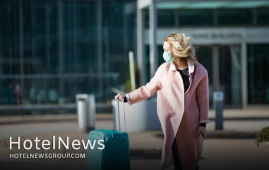
International tourist arrivals were down 83% in the first quarter of 2021 as widespread travel restrictions remained in place. However, the UNWTO Confidence Index shows signs of a slow uptick in confidence. Between January and March 2021 destinations around the world welcomed 180 million fewer international arrivals compared to the first quarter of last year. Asia and the Pacific continued to suffer the lowest levels of activity with a 94% drop in international arrivals over the three-month period. Europe recorded the second largest decline with -83%, followed by Africa (-81%), the Middle East (-78%) and the Americas (-71%). This all follows on from the 73% fall in worldwide international tourist arrivals recorded in 2020, making it the worst year on record for the sector. Lack of coordination harms RestartTourism UNWTO Secretary-General Zurab Pololikashvili comments: “There is significant pent-up demand and we see confidence slowly returning. Vaccinations will be key for recovery, but we must improve coordination and communication while making testing easier and more affordable if we want to see a rebound for the summer season in the northern hemisphere.” Vaccinations will be key for recovery, but we must improve coordination and communication while making testing easier and more affordable if we want to see a rebound for the summer season in the northern hemisphere. The latest survey of the UNWTO Panel of Tourism Experts shows prospects for the May-August period improving slightly. Alongside this, the pace of the vaccination rollout in some key source markets as well as policies to restart tourism safely, most notably the EU Digital Green Certificate, have boosted hopes for a rebound in some of these markets. Overall, 60% expect a rebound in international tourism only in 2022, up from 50% in the January 2021 survey. The remaining 40% see a potential rebound in 2021, though this is down slightly from the percentage in January. Nearly half of the experts do not see a return to 2019 international tourism levels before 2024 or later, while the percentage of respondents indicating a return to pre-pandemic levels in 2023 has somewhat decreased (37%), when compared to the January survey.
Create: Jun 16, 2021 Edit: Jun 16, 2021 International News
Predicting the return of corporate travel would be a cinch if foretelling the future was foolproof. No one, however, has that extraordinary prescience and even if they did, the future is, at best, murky. The continuing popularity of work-from-home arrangements, the COVID-19 induced reluctance of both individuals and companies to get back out on the road, and issues throughout the travel supply chain are all converging to create a less-than-hospitable environment for individual business travelers. “Before you get corporate travel back, you have to get people back to the office,” said Daniel Lesser, President and CEO of LW Hospitality Advisors. “It’s going to be a bit of a slog, at least until Labor Day.” Among the short-term problems, he continued, is airline flight capacity. “A lot of it will have to do with air lift. Carriers are being careful about yield management,” he said. However, Lesser added, “The summer is going to be phenomenal [for leisure travel] but the rubber will hit the road after in terms of group and corporate business.” Shifting BusinessLWHA’s COO and Principal Evan Weiss sees an even more dramatic delay on the horizon. “At the beginning, I thought the recovery would come first with leisure business, then leisure group, corporate transient and then corporate group,” he said. “But there’s been a paradigm shift. Companies now can cut back their travel by, for example, having two in-person board meetings and two on Zoom.” He continued, “After leisure, which is certainly back, we’re thinking corporate groups will be next to come back, and then corporate transient business.” That creates problems for hoteliers. In the U.S., the corporate average room rate in February 2020—the last full month before the coronavirus squeezed the life out of most of the global hotel industry—was $175.15. A year later, it stood at $111.03, down 35.6% year-over-year, according to HotStats data. In Europe, in February 2021, the corporate rate was €77.30, down 35.2% YOY. Meanwhile, in China, corporate travel didn’t have the dramatic swoon seen in other parts of the world. Its lowest point was in April 2020, when the corporate rate hit $65.65, a 24.8% YOY decline. As of April 2021, the $73.03 corporate rate was up 11.2% on the year prior, but still 16% lower than April 2019. The absence of corporate travel is equally disadvantageous since road warriors are typically higher-spending guests than their leisure counterparts. “Corporate folk pay at the last minute, then they book the Ritz-Carlton, and they’re often the ones who drink the most. If you lose that, it’s problematic,” Weiss said. But Chris Green, CEO of third-party management company Chesapeake Hospitality, has a rosier outlook on the return of corporate, framing it in the context of the domino effect. “Once a big player like Bank of America or Deloitte says ‘As long as you’re vaccinated and feel comfortable, you can travel,’ then it’s off to the races,” he said. “I believe companies will say ‘If you’re in a client-facing role, you have to get out there.’” Still, some timid travelers could remain skittish if they don’t feel safe and comfortable back at a hotel, Green noted, meaning properties must get the word out on the extraordinary efforts being taken to keep COVID-19 at bay. To do so, Chesapeake is “asking key questions about traveler confidence and experience and then using responses in sales and marketing presentations,” said Green. The company also is encouraging guests to share their experiences on travel-review sites. “We’re cleaner, safer and more sanitized than we’ve ever been,” Green said. “That needs to be the front-facing message because companies must feel certain that the hotels where they’re putting travelers are good citizens.”
Create: May 25, 2021 Edit: May 25, 2021 Hotel Management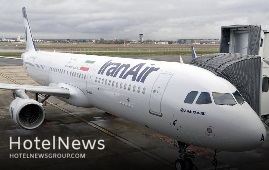
The average of international travels to and from Iran fell by 80 percent during the past Iranian calendar year 1399 (ended on March 20, 2021) from a year earlier. “During this period, 4,343,163 passengers entered the country, which included 3,030,464 Iranian passengers and 512,699 international travelers,” Mehr quoted Arezou Ghaniun, an official with the Islamic Republic of Iran's Customs Administration, as saying on Saturday. “From the beginning of 1399 to the end of it, we saw a significant reduction in passenger traffic to the country or vice versa in land, sea, rail and air borders, which were caused by various coronavirus restrictions.” International tourist arrivals to Iran plunged 72% during the first eight months of the year when compared to 2019, according to data compiled by the World Tourism Organization. Restrictions on travel introduced in response to the COVID-19 pandemic continue to hit global tourism hard, with the latest data from the UNWTO showing a 70% fall in international arrivals for the first eight months of 2020. Iran, however, has experienced different rates of downfall for inbound passengers over the past months. In the first three months of 2020 (January, February, March), the tourism industry of the country recorded negative rates of 90, 92, and 94 percent, respectively, compared to the same period last year, according to the organization. The fall reached 96 and 97 percent in April and May. And in June, a negative 84% was recorded. But the interesting point in the statistics published by the World Tourism Organization is a steep slope of the improvement of Iran’s tourism arrivals during the last two months, as such growth has leaped 35% in July and August. Optimistic forecasts, expect the country would achieve a tourism boom after coronavirus contained, believing its impact would be temporary and short-lived for a country that ranked the third fastest-growing tourism destination in 2019. According to the newest UNWTO Barometer, international arrivals plunged 81% in July and 79% in August, traditionally the two busiest months of the year and the peak of the Northern Hemisphere summer season. The drop until August represents 700 million fewer arrivals compared to the same period in 2019 and translates into a loss of US$ 730 billion in export revenues from international tourism. This is more than eight times the loss experienced on the back of the 2009 global economic and financial crisis. “This unprecedented decline is having dramatic social and economic consequences, and puts millions of jobs and businesses at risk,” warned UNWTO Secretary-General Zurab Pololikashvili. “This underlines the urgent need to safely restart tourism, in a timely and coordinated manner”. UNWTO’s Panel of Experts foresees a rebound in international tourism in the current year, mostly in the third quarter. However, some experts suggest the rebound could occur only in 2022. Travel restrictions are seen as the main barrier standing in the way of the recovery of international tourism, along with slow virus containment and low consumer confidence. The lack of coordinated response among countries to ensure harmonized protocols and coordinated restrictions, as well as the deteriorating economic environment, were also identified by experts as important obstacles for recovery. The Islamic Republic expects to reap a bonanza from its numerous tourist spots such as bazaars, museums, mosques, bridges, bathhouses, madrasas, mausoleums, churches, towers, and mansions, of which 24 being inscribed on the UNESCO World Heritage list. Under the 2025 Tourism Vision Plan, Iran aims to increase the number of tourist arrivals from 4.8 million in 2014 to 20 million in 2025.
Create: May 16, 2021 Edit: May 16, 2021 Regional News
A vast tourism complex is being constructed in Pakdasht, near the Iranian capital, Pakdasht’s tourism chief has said. The project is expected to create 330 job opportunities directly, Asadollah Tajik added. The complex, which covers an area of 3,200 square meters, includes a traditional restaurant, traditional bathhouse, flower market, conference halls, museums, and accommodation units, the official explained. The project is scheduled to be completed within the next five years, he said. He also noted that establishing such complexes could boost tourism in the region. Hugging the lower slopes of the magnificent, snowcapped Alborz Mountains, Tehran is much more than a chaotic jumble of concrete and crazy traffic blanketed by a miasma of air pollution. This is the nation's dynamic beating heart and the place to get a handle on modern Iran and what its future will likely be. The metropolis has many to offer its visitors including Golestan Palace, Grand Bazaar, Treasury of National Jewels, National Museum of Iran, Glass & Ceramic Museum, Masoudieh Palace, Sarkis Cathedral, Tehran Museum of Contemporary Art, Carpet Museum of Iran, to name a few. The first time Tehran is mentioned in historical accounts is in an 11th-century chronicle in which it is described as a small village north of Ray. It became the capital city of the Seljuk Empire in the 11th century but later declined with factional strife between different neighborhoods and the Mongol invasion of 1220. Photo: File photo depicts construction workers at a building site in Tehran.
Create: May 11, 2021 Edit: May 11, 2021 Regional News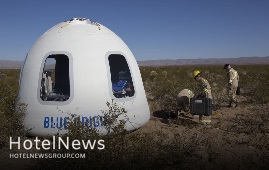
Blue Origin announced May 5 that it will fly people on its New Shepard suborbital vehicle for the first time July 20, and will auction off one of the seats on that launch. The company said that, after years of test flights without anyone on board, it will start flying people on New Shepard. The announcement took place 60 years to the day after the vehicle’s namesake, Alan Shepard, became the first American space on the suborbital Mercury 3 launch. The scheduled date of the flight is the 52nd anniversary of the Apollo 11 landing. The company hinted during its most recent test flight of the vehicle April 14 that it was ready to start flying people on the vehicle. The company used the flight to test procedures for future crew flights, including having company personnel, playing the role of customers, boarding the vehicle during prelaunch preparations, and also practicing exiting the vehicle after landing. “We have flown this vehicle 15 times and, after the last flight, we said, ‘It’s time. Let’s put people on board,’” said Ariane Cornell, director of astronaut sales at Blue Origin, in a call with reporters. The company did not disclose who would fly on the vehicle, capable of carrying six people, beyond that it will make one seat available to the public via an auction. The company will accept sealed bids through May 19, then go into an unsealed bidding phase, concluding in a live auction June 12. Blue Origin said the proceeds of the auction will go to an affiliated nonprofit organization, the Club for the Future, that supports STEM education activities. When Blue Origin announced April 29 that it would disclose its plans for selling the first seat on New Shepard, many expected it would formally unveil long-awaited plans to start selling tickets. The company has said little about its ticket sales strategy, including how much they would cost. Cornell declined to discuss how the company would sell tickets beyond this initial auction. “We don’t have details on the prices for future seats, and we will announce the details of how those future seats will be sold in the future, after this auction.” She added the company will take notes of the “most active bidders” in that auction for follow-up on future ticket sales. She also said that, after the July 20 flight, “we will have a couple more crewed flights before the end of the year.” While the company didn’t disclose details on ticket sales, the company is sharing more information on the spaceflight experience. Cornell said that those who fly on New Shepard will arrive at the company’s West Texas site four days before launch and undergo three days of training. That will include working in a mockup of the New Shepard crew capsule learning procedures for getting in and out of the vehicle as well as emergency protocols. Those who fly New Shepard have to meet a number of physical and other conditions, according to a terms and conditions document posted on the company’s website. That includes being at least 18 years old, weighing between 50 and 101 kilograms, being between 152 to 193 centimeters tall, and able to withstand 3g’s of acceleration during launch and 5.5g’s “for a few seconds” during reentry. Blue Origin didn’t disclose how many people signaled an interest in flying on New Shepard by signing up on its website in the last week to find out how they could buy tickets. “I can say that the website has gotten a workout in the last week,” Cornell said. “Obviously, we hope that is a good precursor to excitement and participation in the auction on June 12.” Loizos Heracleous, professor of strategy at the Warwick Business School, noted that there are about six million people worldwide with a net worth of at least $5 million, and thus likely in the addressable market for a flight like this. “For some it will be about bragging rights, for others it will be an experience of a lifetime,” he said in a statement about why people would be willing to pay a premium to fly on a suborbital vehicle. “In strict financial terms it might not seem a wise decision, but if it’s a small part of their disposable income or net worth, they might want to do it.”
Create: May 8, 2021 Edit: May 8, 2021 International News
At a time when many of the world’s events continue to be plagued by COVID-19, making plans even a week in advance may seem difficult, much less 10 years into the future. Nearly overnight, the dialogue shifted from “where to for lunch?” to “can you hear me?”. And as hotels emptied out and travel restrictions drag on, many may wonder, where lies the future of hotels? To answer this question, it is first important to recognize that the hotel sector does not exist as an individual silo, but one which forms part of a much wider network: the ecosystem of how we live and work. The cities in which we live today are a reflection of how humans have shaped our environments to fit our social and economic needs. For generations, urban agglomeration had been the standard of cities, and central business districts (CBDs) thrived as we commuted between living in one area and working in another. Accordingly, hotels have typically focused on serving transient international or regional visitors, primarily playing one of two roles: a place to sleep and meet during our business travels, or a place of respite for our leisure getaways. Today, rising interest in (semi-) permanent remote working and a greater desire to live outside of high-density urban areas may signal yet another impending change in the way we live and work. Could deurbanization or decentralization continue on this trajectory – and what would that mean for hotels? In a Cushman & Wakefield webinar, Richard Pickering, Chief Strategy Officer, EMEA and Borivoj Vokrinek, Strategic Advisory and Head of Hospitality Research EMEA from Cushman & Wakefield, traced the paths of how our societies and hotels have evolved, from their very beginnings to where they could be in the future. Blast from the past: The evolution of travel, from immobile to transient lifestyles Since the early days of civilization, the structure of our society has dictated where we lay our heads every night. When humans lived in self-sufficient tribes and settlements, there was no need to travel or sleep anywhere other than in our own beds; while as society progressed, business travel dominated as merchants travelled for trade. And then, with higher disposable incomes, more free time, rising globalization and the internationalisation of trade, there came the birth of mass leisure and business travel. Clearly, humans have become increasingly mobile – and the advancement of technology will only continue to push us towards this trend. Similarly, the role of accommodation providers has also evolved immensely with our changing social and technological landscape. From being a place for shelter and food to becoming a place to meet and then emerging as a provider of experiences, hotels have always evolved alongside our society and the cities in which we live. In today’s context, our ‘social awakening’ has brought rising calls for better work-life balance and a heightened desire to travel and ‘unwind’. To perpetuate this image, hotels have taken on an additional role: a promoter of one’s social status, driven by the growing prevalence of social media. Yet, this evolution will not end there – with our growing mobility, the role of hotels will only continue to expand to meet our transient needs. “There’s no virtual pivot for hotels,” Pickering emphasized. As our society and cities continue to evolve, so will hotels. ‘The variable impact (of COVID-19) on different sectors’ – C&W Webinar Part 1 of 2: Evolution of our cities and what it means for real estate, presented by Richard Pickering. Note: The relative positionings are for illustration purposes only. Swimming against the current – the rise of remote working Our cities of today, however, have been far from perfect, in fact, some may even argue that urbanisation in the developed world has become a myth. “In city centres, centralized demand, when combined with scarce supplies, pushes up rents for businesses as well as housing costs. [Meanwhile,] increasing city sizes means increasing commute times, which reduces free time and worsens pollution – all while our creaking infrastructure amplifies the penalties of distance,” Pickering suggested. It is unsurprising, therefore, to see an increasing number of digital nomads who choose to forego homeownership entirely to traverse the world in search of the much-revered triple-threat ‘office spaces’: stable Wi-Fi, multiple charging points and good coffee. In fact, as Global Workplace Analytics estimates that 25-30% of the workforce will telecommute multiple days a week by the end of 2021, some argue that ‘working from home’ may eventually become ‘work from anywhere’. And with a number of hotels already offering ‘work from hotel’ packages or even subscription services, it is evident that hotels are well-placed to capitalize on this trend. Forward to the future: Super-commuters in a decentralized world. As the idea of remote working with occasional commutes to the workplace gains wider acceptance from both employers and employees, it seems that we are at the tipping point of a new emerging trend: super-commuting. Super-commuters live in one city or country while their office is in another, commuting between the two from time to time – and this will have implications for hotels. “In the future, if more of the workforce is living in remote areas, it is actually likely that they will use hotel accommodation more frequently [for the days that they do travel to the office],” Vokrinek explained. Importantly, increased remote working does not mean a lesser need for meetings and social interactions – rather, the contrary is most likely true. “Not only will employees be living further away and have fewer interactions amongst each other, but clients will also be living outside of cities. So, there would be a need for more structured [and deliberate] meetings, not only on an international scale, but locally and regionally as well – and that will drive demand for meeting facilities in hotels,” Vokrinek suggested. In fact, not only will the role of hotels evolve, but there will likely be a greater need for hotels in the smaller communities that will form in these areas where such super-commuters will typically work from. “Historically, those towns and places were probably mostly residential, with limited [interest from investors] and limited amenities. However, if people will be living in those local hubs on a regular basis and commute less to the central core office, there will be a need for amenities in those local hubs and this will include hotels. Of course, the demand will be softer, so the hotels will probably be smaller. They will need to be more flexible; most likely a hybrid concept within mixed-use developments, [but there will be a need for them”] explained Vokrinek. ‘Hotels within a new eco-system of workspaces’ – C&W Webinar Part 2 of 2: The role of hotels as cities evolve, presented by Borivoj Vokrinek. The who and the why? Towards a new kind of work-life balance Although the notion of such super-commuters forming a considerable proportion of our workforce seems to lie somewhere in the distant future, with the prevalence of low-cost airlines and the advancements of technology, experts speculated, as early as 2014, that there could already be hundreds of thousands of super-commuters worldwide. This decentralization of the workplace is likely to pick up not only because of our increased mobility and higher level of comfort with remote working, but also due to the attractive benefits it may bring to both employees and employers. As Pickering explained, “In a digitally enabled world where distance no longer matters, […] I see a real opportunity for employees to derive labour arbitrage and live a better life” – even taking a small pay cut from a London salary to work from the Greek island of Kefalonia could be well worth the trade-off”. On the flip side, employers may also realize that sourcing the best (and/or cheaper) talent will no longer be bound by geographical borders. And with higher pressure on costs, especially in the short-term, employers too may find themselves increasingly attracted to the lure of allowing super-commuting. The shift, not death of business travel Many soothsayers have begun lamenting the death of business travel, citing the rise of video conferencing and growing realization that not all meetings call for an 8-hour flight and 2-hour layover. However, while the increased usage of video conferencing will undeniably replace some business travel, especially in the short-term, it would be hasty to presume that this would necessarily lead to a significant decline in business travel in the long-term. Rather, as we become increasingly accustomed to living a mobile lifestyle and working remotely, this emerging form of business travel will likely broaden the opportunities for hotels, through catering to the needs of a more decentralized workforce and their clientele. As Vokrinek further suggested, “Some part of the demand will become more regular and predictable, and this will open opportunities for more membership or subscription concepts and increase the importance of loyalty programmes.” Despite the short-term challenges faced by the hotel industry, it is evident that the role of hotels has constantly expanded to meet the new needs of the times – and there is no reason to assume that this time will be any different. Our society is undoubtedly becoming ever more transient, spending more time outside of our homes. But even then, we will still need places to eat, sleep, work and relax. With the rise of remote working, we will likely crave physical interactions and seek places to meet with others more than ever before. Therefore, while the current pandemic has had an indescribable impact on the hotel sector, its long-term implication is that it has catalysed the evolution of how and where we live and work, with hotels destined to play a much bigger role in our increasingly mobile lifestyles and new work ecosystems.
Create: May 6, 2021 Edit: May 6, 2021 Hotel Management
The devastating impact of the COVID-19 pandemic on global tourism has carried on into 2021, with new data showing an 87% fall in international tourist arrivals in January as compared to 2020. The outlook for the rest of the year remain cautious as the World Tourism Organization (UNWTO) continues to call for stronger coordination on travel protocols between countries to ensure the safe restart of tourism and avoid another year of massive losses for the sector. Following a difficult end to 2020, global tourism suffered further setbacks in the beginning of the year as countries tightened travel restrictions in response to new virus outbreaks. According to the latest edition of the UNWTO World Tourism Barometer, all world regions continued to experience large drops in tourist arrivals in the first month of the year. Mandatory testing, quarantines, and in some cases the complete closure of borders, have all hindered the resumption of international travel. In addition, the speed and distribution of the vaccination roll-out have been slower than expected, further delaying the restart of tourism. All global regions hit hardAsia and the Pacific (-96%), the region which continues to have the highest level of travel restrictions in place, recorded the largest decrease in international arrivals in January. Europe and Africa both saw a decline of 85% in arrivals, while the Middle East recorded a drop of 84%. International arrivals in the Americas decreased by 77% in January, following somewhat better results in the last quarter of the year. UNWTO Secretary-General Zurab Pololikashvili said: “2020 was the worst year on record for tourism. The international community needs to take strong and urgent action to ensure a brighter 2021. Many millions of livelihoods and businesses are depending on it. Improved coordination between countries and harmonized travel and health protocols are essential to restore confidence in tourism and allow international travel to resume safely ahead of the peak summer season in the northern hemisphere.” Outlook for 2021With 32% of all global destinations completely closed to international tourists at the beginning of February, UNWTO anticipates a challenging first few months of 2021 for global tourism. Based on current trends, UNWTO expects international tourist arrivals to be down about 85% in the first quarter of 2021 over the same period of 2019. This would represent a loss of some 260 million international arrivals when compared to pre-pandemic levels. Looking ahead, UNWTO has outlined two scenarios for 2021, which consider a possible rebound in international travel in the second half of the year. These are based on a number of factors, most notably a major lifting of travel restrictions, the success of vaccination programmes or the introduction of harmonized protocols such as the Digital Green Certificate planned by the European Commission. The first scenario points to a rebound in July, which would result in a 66% increase in international arrivals for the year 2021 compared to the historic lows of 2020. In this case, arrivals would still be 55% below the levels recorded in 2019. The second scenario considers a potential rebound in September, leading to a 22% increase in arrivals compared to last year. Still, this would be 67% below the levels of 2019.
Create: Apr 3, 2021 Edit: Apr 3, 2021 International News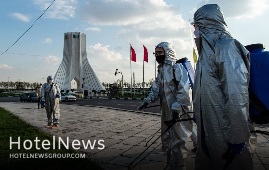
The number of foreign visitors to Iran plunged 94% in the first nine months of the current Iranian calendar year (started March 20, 2020), from a year earlier, government data showed on Wednesday, as the coronavirus pandemic takes a heavy toll of the tourism industry. “Some 450,000 foreign travelers arrived in Iran for mainly medical or trade purposes during the first nine months of the year… tightened measures to tackle the new coronavirus has reduced international travel to the country by 94 percent,” Vali Teymouri, the deputy tourism minister, announced on Wednesday. The global tourism industry has been plagued by the outbreak of the coronavirus for more than a year, which is a record in the history of this industry, the official noted. In an interview with the Tehran Times, the official noted: “We need to revise marketing strategies, and to redefine tourism products by paying great attention to nature tours, rural tourism, and ecotourism, agricultural tourism as a tool to empower local communities and travel businesses.” The coronavirus epidemic has ruined more than 1.5 million jobs in Iran’s travel sector, tourism minister Ali-Asghar Mounesan said in December. “Over 1.5 million jobs have been lost in the tourism sector of Iran due to the COVID-19 disease…. Many of the tourism-insiders are now unemployed or they are staying at home,” Mounesan said. The county’s travel sector has suffered a loss of 140 trillion rials (some $3.3 billion at the official rate of 42,000 rials) since the outbreak of the coronavirus pandemic till the end of Shahrivar (Sep. 21), the official added. Mounesan publicized last November that mass, unplanned travels are not approved, adding: “The outbreak of the coronavirus has caused damage to the tourism industry in Iran and [other parts of] the world in such a way that according to statistics, 50 million people are directly and indirectly exposed to unemployment due to the virus spread in the global scene…. yet, mass or unplanned and irresponsible travels are not approved to take place during the coronavirus era.” Smart and responsible traveling should replace "do not travel” recommendations, the minister stressed, adding: “In our country, Corona has caused problems in the tourism industry and the worrying point is the continuation of this trend.” Tourism [industry of Iran] was growing before the corona [outbreak], its revenues reached $11.7 billion in 2019, which accounted for 2.8% of GDP, near the average share of tourism in the world GDP, which was 3.2 percent, the minister explained. He said 8.7 million foreign nationals visited Iran during the past [Iranian] year (1398), adding that Iran was ranked as the second fastest-growing country in tourism based on data compiled by the World Tourism Organization. “On the onset of coronavirus, tourism faced a sharp decline in the world including our country. So that in the first three months of the current [Iranian] year the number of foreign tourists dropped to 74 --- it was reached almost zero!.”
Create: Feb 20, 2021 Edit: Feb 20, 2021 Regional News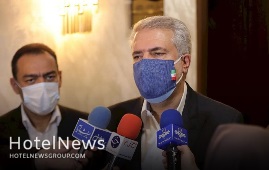
Iranian tourism minister Ali-Asghar Mounesan on Tuesday inaugurated 206 tourism-related projects in Tehran province through a video conference. The tourism infrastructure of Tehran province is essentially needed to be developed due to its political and commercial importance, IRNA quoted the minister as saying during the inauguration ceremony. The projects, which include hotels, apartment hotels, eco-lodge units, tourist complexes, boutique hotels, traditional restaurants, travel agencies, and handicrafts workshops, are estimated to generate 936 jobs. Furthermore, the mentioned projects will be adding 816 beds to the hospitality sector of the Iranian capital. Establishing more eco-lodges as well as different types of accommodation centers could facilitate traveling and staying in this metropolis, the minister said. Referring to the outbreak of the coronavirus and the problems and issues it has caused to the travel sector, Mounesan noted that smart travels under the supervision of the tourism and health ministries is the only way to overcome the current situation. Hugging the lower slopes of the magnificent, snowcapped Alborz Mountains, Tehran is much more than a chaotic jumble of concrete and crazy traffic blanketed by a miasma of air pollution. This is the nation's dynamic beating heart and the place to get a handle on modern Iran and what its future will likely be. The metropolis has many to offer its visitors including Golestan Palace, Grand Bazaar, Treasury of National Jewels, National Museum of Iran, Glass & Ceramic Museum, Masoudieh Palace, Sarkis Cathedral, Tehran Museum of Contemporary Art, Carpet Museum of Iran, to name a few. The first time Tehran is mentioned in historical accounts is in an 11th-century chronicle in which it is described as a small village north of Ray. It became the capital city of the Seljuk Empire in the 11th century but later declined with factional strife between different neighborhoods and the Mongol invasion of 1220.
Create: Feb 20, 2021 Edit: Feb 20, 2021 Regional News
Wyndham Hotels & Resorts (NYSE: WH) today announced results for the three months and year ended December 31, 2020. Highlights include: Diluted loss per share for the quarter was $0.08 and adjusted diluted earnings per share was $0.07; diluted loss per share for the full-year was $1.42 and adjusted diluted earnings per share was $1.03. Net loss for the quarter was $7 million and adjusted net income was $7 million; net loss for the full-year was $132 million and adjusted net income was $96 million. Adjusted EBITDA was $56 million for the quarter and $327 million for the full-year. Global comparable RevPAR for the quarter declined 33% year-over-year; global comparable RevPAR for the year declined 35% year-over-year. System-wide rooms declined 4% year-over-year. Net cash provided by operating activities for the full-year was $67 million and free cash flow was $34 million. Paid quarterly cash dividend of $0.08 per share in fourth quarter, and Board of Directors recently authorized a 100% increase in the quarterly cash dividend to $0.16 per share beginning with the dividend expected to be declared in first quarter 2021. Repaid all remaining revolver credit facility borrowings. “We generated strong adjusted EBITDA and free cash flow in the worst year our industry has ever experienced. At the same time, we strengthened our portfolio with the completion of our strategic termination plan and drove sequential growth in hotel openings and our development pipeline,” said Geoffrey A. Ballotti, president and chief executive officer. “Our non-urban, drive-to economy and midscale hotels, combined with our ongoing investment in sales and marketing, captured rising pent-up leisure travel demand, which continued to produce sequential RevPAR improvements and domestic market share gains for our franchisees over the course of 2020.” Fourth Quarter 2020 Operating Results Revenues declined from $492 million in the fourth quarter of 2019 to $296 million in the fourth quarter of 2020. The decline includes lower pass-through cost-reimbursement revenues of $70 million, which have no impact on adjusted EBITDA, in the Company’s hotel management business. Excluding cost-reimbursement revenues, revenues declined $126 million primarily reflecting a 33% decline in comparable RevPAR and the impact from hotels temporarily closed due to COVID-19, as well as a $15 million decline in license and other fees also reflecting the impact of COVID-19 on travel demand globally. The Company generated a net loss of $7 million, or $0.08 per diluted share, compared to net income of $64 million, or $0.68 per diluted share, in the fourth quarter of 2019. The decrease of $71 million, or $0.76 per diluted share, was primarily due to the RevPAR and license fee declines, as well as excess marketing fund spend, which were partially offset by cost containment initiatives, lower volume-related expenses and the absence of transaction-related expenses. Full reconciliations of GAAP results to the Company’s non-GAAP adjusted measures for all reported periods appear in the tables to this press release. Full-Year 2020 Operating Results Revenues declined from $2,053 million in 2019 to $1,300 million in 2020. The decline includes lower pass-through cost-reimbursement revenues of $273 million, which have no impact on adjusted EBITDA, in the Company’s hotel management business. Excluding cost-reimbursement revenues, revenues declined $480 million primarily reflecting a 35% decline in comparable RevPAR and the impact from hotels temporarily closed due to COVID-19, as well as a $47 million decline in license and other fees also reflecting the impact of COVID-19 on travel demand globally. The Company generated a net loss of $132 million, or $1.42 per diluted share, in 2020 compared to net income of $157 million, or $1.62 per diluted share, in 2019. The decline of $289 million, or $3.04 per diluted share, was primarily due to the revenue decline, impact of the non-cash impairment charges and excess marketing fund spend, which were partially offset by cost containment initiatives, lower volume-related, separation-related and transaction-related expenses and the absence of contract termination expenses. Full reconciliations of GAAP results to the Company’s non-GAAP adjusted measures for all reported periods appear in the tables to this press release.
Create: Feb 13, 2021 Edit: Feb 13, 2021 International News
